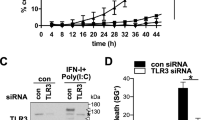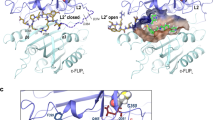Abstract
Apoptosis-associated speck-like protein containing a CARD (ASC) is an adaptor molecule that mediates apoptotic and inflammatory signals, and implicated in tumor suppression. However, the mechanism of ASC-mediated apoptosis has not been well elucidated. Here, we investigated the molecular mechanisms of ASC-mediated apoptosis in several cell lines using a caspase recruitment domain 12-Nod2 chimeric protein that transduces the signal from muramyl dipeptide into ASC-mediated apoptosis. Experiments using dominant-negative mutants, small-interfering RNAs and peptide inhibitors for caspases indicated that caspase-8 was generally required for ASC-mediated apoptosis, whereas a requirement for caspase-9 depended on the cell type. In addition, caspase-like apoptosis-regulatory protein (CLARP)/Fas-like inhibitor protein, a natural caspase-8 inhibitor, suppressed ASC-mediated apoptosis, and Clarp−/− mouse embryonic fibroblasts were highly sensitive to ASC-mediated apoptosis. Bax-deficient HCT116 cells were resistant to ASC-mediated apoptosis as reported previously, although we failed to observe colocalization of ASC and Bax in cells. Like Fas-ligand-induced apoptosis, the ASC-mediated apoptosis was inhibited by Bcl-2 and/or Bcl-XL in type-II but not type-I cell lines. Bid was cleaved upon ASC activation, and suppression of endogenous Bid expression using small-interfering RNAs in type-II cells reduced the ASC-mediated apoptosis. These results indicate that ASC, like death receptors, mediates two types of apoptosis depending on the cell type, in a manner involving caspase-8.
This is a preview of subscription content, access via your institution
Access options
Subscribe to this journal
Receive 50 print issues and online access
$259.00 per year
only $5.18 per issue
Buy this article
- Purchase on Springer Link
- Instant access to full article PDF
Prices may be subject to local taxes which are calculated during checkout







Similar content being viewed by others
References
Bullani RR, Huard B, Viard-Leveugle I, Byers HR, Irmler M, Saurat JH et al. (2001). Selective expression of FLIP in malignant melanocytic skin lesions. J Invest Dermatol 117: 360–364.
Damiano JS, Newman RM, Reed JC . (2004). Multiple roles of CLAN (caspase-associated recruitment domain, leucine-rich repeat, and NAIP CIIA HET-E, and TP1-containing protein) in the mammalian innate immune response. J Immunol 173: 6338–6345.
Du C, Fang M, Li Y, Li L, Wang X . (2000). Smac, a mitochondrial protein that promotes cytochrome c-dependent caspase activation by eliminating IAP inhibition. Cell 102: 33–42.
Elnemr A, Ohta T, Yachie A, Kayahara M, Kitagawa H, Fujimura T et al. (2001). Human pancreatic cancer cells disable function of Fas receptors at several levels in Fas signal transduction pathway. Int J Oncol 18: 311–316.
Geddes BJ, Wang L, Huang WJ, Lavellee M, Manji GA, Brown M et al. (2001). Human CARD12 is a novel CED4/Apaf-1 family member that induces apoptosis. Biochem Biophys Res Commun 284: 77–82.
Gumucio DL, Diaz A, Schaner P, Richards N, Babcock C, Schaller M et al. (2002). Fire and ICE: the role of pyrin domain-containing proteins in inflammation and apoptosis. Clin Exp Rheumatol 20: S45–53.
Hasegawa M, Imamura R, Kinoshita T, Matsumoto N, Masumoto J, Inohara N et al. (2005). ASC-mediated NF-kappa B activation leading to IL-8 production requires caspase-8 and is inhibited by CLARP. J Biol Chem 280: 15122–15130.
Imamura R, Konaka K, Matsumoto N, Hasegawa M, Fukui M, Mukaida N et al. (2004). Fas ligand induces cell-autonomous NF-kappa B activation and IL-8 production by a mechanism distinct from that of TNF-alpha. J Biol Chem 279: 46415–46423.
Inohara N, Koseki T, del Peso L, Hu Y, Yee C, Chen S et al. (1999). Nod1, an Apaf-1-like activator of caspase-9 and nuclear factor-kappaB. J Biol Chem 274: 14560–14567.
Inohara N, Koseki T, Hu Y, Chen S, Nunez G . (1997). CLARP, a death effector domain-containing protein interacts with caspase-8 and regulates apoptosis. Proc Natl Acad Sci USA 94: 10717–10722.
Jesenberger V, Procyk KJ, Yuan J, Reipert S, Baccarini M . (2000). Salmonella-induced caspase-2 activation in macrophages: a novel mechanism in pathogen-mediated apoptosis. J Exp Med 192: 1035–1046.
Li H, Zhu H, Xu CJ, Yuan J . (1998). Cleavage of BID by caspase 8 mediates the mitochondrial damage in the Fas pathway of apoptosis. Cell 94: 491–501.
Luo X, Budihardjo I, Zou H, Slaughter C, Wang X . (1998). Bid, a Bcl2 interacting protein, mediates cytochrome c release from mitochondria in response to activation of cell surface death receptors. Cell 94: 481–490.
Mariathasan S, Newton K, Monack DM, Vucic D, French DM, Lee WP et al. (2004). Differential activation of the inflammasome by caspase-1 adaptors ASC and Ipaf. Nature 430: 213–218.
Mariathasan S, Weiss DS, Dixit VM, Monack DM . (2005). Innate immunity against Francisella tularensis is dependent on the ASC/caspase-1 axis. J Exp Med 202: 1043–1049.
Martinon F, Burns K, Tschopp J . (2002). The inflammasome: a molecular platform triggering activation of inflammatory caspases and processing of proIL-beta. Mol Cell 10: 417–426.
Masumoto J, Dowds TA, Schaner P, Chen FF, Ogura Y, Li M et al. (2003). ASC is an activating adaptor for NF-kappa B and caspase-8-dependent apoptosis. Biochem Biophys Res Commun 303: 69–73.
Mathas S, Lietz A, Anagnostopoulos I, Hummel F, Wiesner B, Janz M et al. (2004). c-FLIP mediates resistance of Hodgkin/Reed–Sternberg cells to death receptor-induced apoptosis. J Exp Med 199: 1041–1052.
McConnell BB, Vertino PM . (2000). Activation of a caspase-9-mediated apoptotic pathway by subcellular redistribution of the novel caspase recruitment domain protein TMS1. Cancer Res 60: 6243–6247.
McConnell BB, Vertino PM . (2004). TMS1/ASC: the cancer connection. Apoptosis 9: 5–18.
Ogura Y, Inohara N, Benito A, Chen FF, Yamaoka S, Nunez G . (2001). Nod2, a Nod1/Apaf-1 family member that is restricted to monocytes and activates NF-kappaB. J Biol Chem 276: 4812–4818.
Ohtsuka T, Ryu H, Minamishima YA, Macip S, Sagara J, Nakayama KI et al. (2004). ASC is a Bax adaptor and regulates the p53–Bax mitochondrial apoptosis pathway. Nat Cell Biol 6: 121–128.
Poyet JL, Srinivasula SM, Tnani M, Razmara M, Fernandes-Alnemri T, Alnemri ES . (2001). Identification of Ipaf, a human caspase-1-activating protein related to Apaf-1. J Biol Chem 276: 28309–28313.
Sadasivam S, Gupta S, Radha V, Batta K, Kundu TK, Swarup G . (2005). Caspase-1 activator Ipaf is a p53-inducible gene involved in apoptosis. Oncogene 24: 627–636.
Scaffidi C, Fulda S, Srinivasan A, Friesen C, Li F, Tomaselli KJ et al. (1998). Two CD95 (APO-1/Fas) signaling pathways. EMBO J 17: 1675–1687.
Sun XM, Bratton SB, Butterworth M, MacFarlane M, Cohen GM . (2002). Bcl-2 and Bcl-xL inhibit CD95-mediated apoptosis by preventing mitochondrial release of Smac/DIABLO and subsequent inactivation of X-linked inhibitor-of-apoptosis protein. J Biol Chem 277: 11345–11351.
Thome M, Tschopp J . (2001). Regulation of lymphocyte proliferation and death by FLIP. Nat Rev Immunol 1: 50–58.
van Loo G, Saelens X, van Gurp M, MacFarlane M, Martin SJ, Vandenabeele P . (2002). The role of mitochondrial factors in apoptosis: a Russian roulette with more than one bullet. Cell Death Differ 9: 1031–1042.
Wang L, Manji GA, Grenier JM, Al-Garawi A, Merriam S, Lora JM et al. (2002). PYPAF7, a novel PYRIN-containing Apaf1-like protein that regulates activation of NF-kappa B and caspase-1-dependent cytokine processing. J Biol Chem 277: 29874–29880.
Wang Y, Hasegawa M, Imamura R, Kinoshita T, Kondo C, Konaka K et al. (2004). PYNOD, a novel Apaf-1/CED4-like protein is an inhibitor of ASC and caspase-1. Int Immunol 16: 777–786.
Yeh WC, Itie A, Elia AJ, Ng M, Shu HB, Wakeham A et al. (2000). Requirement for Casper (c-FLIP) in regulation of death receptor-induced apoptosis and embryonic development. Immunity 12: 633–642.
Zender L, Hutker S, Liedtke C, Tillmann HL, Zender S, Mundt B et al. (2003). Caspase 8 small interfering RNA prevents acute liver failure in mice. Proc Natl Acad Sci USA 100: 7797–7802.
Acknowledgements
This work was supported in part by Grants-in-Aid for Scientific Research on Priority Areas (Cancer) from the Ministry of Education, Culture, Sports, Science and Technology, the Japanese Government and a grant from the Novartis Foundation (Japan) for the Promotion of Science.
Author information
Authors and Affiliations
Corresponding author
Additional information
Supplementary Information accompanies the paper on Oncogene website (http://www.nature.com/onc).
Rights and permissions
About this article
Cite this article
Hasegawa, M., Kawase, K., Inohara, N. et al. Mechanism of ASC-mediated apoptosis: Bid-dependent apoptosis in type II cells. Oncogene 26, 1748–1756 (2007). https://doi.org/10.1038/sj.onc.1209965
Received:
Revised:
Accepted:
Published:
Issue Date:
DOI: https://doi.org/10.1038/sj.onc.1209965
Keywords
This article is cited by
-
Comparison of MS2, synchronous precursor selection MS3, and real-time search MS3 methodologies for lung proteomes of hydrogen sulfide treated swine
Analytical and Bioanalytical Chemistry (2021)
-
Caspase-1 initiates apoptosis in the absence of gasdermin D
Nature Communications (2019)
-
Methylation of ASC/TMS1 promoter is associated with poor prognosis of patients with gastric cancer
Clinical and Translational Oncology (2016)
-
Epigenetic regulation of ASC/TMS1 expression: potential role in apoptosis and inflammasome function
Cellular and Molecular Life Sciences (2014)
-
Pathways of Tumor development and progression in Drug-induced Nonmelanoma Skin Cancer: a New Hope or the Next Great Confusion?
Wiener Medizinische Wochenschrift (2014)



